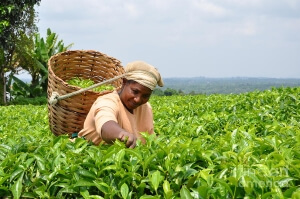Tea production in Kenya, the world’s biggest exporter of the black variety of the leaves, may miss the government’s targeted 25 percent increase this year as an extended dry spell damages the crop. Coffee output will also be hurt.
The La Nina weather phenomenon, which causes dryness in eastern Africa, is replacing the rain-inducing El Nino effect that resulted in heavy rainfall from October to December and helped boost tea output in the Central and Rift Valley growing regions by more than a third in the first eight months of 2016 from a year earlier.
La Nina may cut precipitation in the final three months of this year, and “the tea leaves are becoming dry and falling off,” Johnson Irungu, the Agriculture Ministry’s director of crops, said in an Oct. 25 interview in the capital, Nairobi. Production volumes shrank after the bumper harvest in the first quarter, meaning the industry may fall short of a 500 million-kilogram (1.1 million-pound) government target for the year, he said.
The drought in east Africa’s biggest economy, which relies on exports of tea as its biggest source of foreign exchange after diaspora remittances, means about 1.3 million people in almost half of Kenya’s 47 counties are facing food insecurity, the ministry said last week. While farmers use irrigation in times of low rainfall, dams and other water sources are drying up, causing concern especially for small scale-farmers, who account for 60 percent of Kenya’s tea production, Irungu said.
Output, Revenue
Kenya is the world’s largest grower of the leaves after China and India, but exports 95 percent of its output, making it the biggest shipper of the crop. Last year, the East African nation produced 399.5 million kilograms and made $1.24 billion from exports. It harvested 308.1 million kilograms in the first eight months of 2016.
The average African tea price dropped 16 percent this year to $2.29 per kilogram at the latest weekly auction in Mombasa, the world’s biggest for the leaves. Revenue may decline this year if prices at the auction don’t pick up, Irungu said.
A two-week strike by tea pickers at the end of June also reduced this year’s harvest, according to the East African Tea Traders Association. Workers that were demanding a 30 percent wage increase resumed duty for half the amount, but the issue is still hanging over the industry as no long-term agreement was reached.
Kenya’s coffee crop is also being damaged by the drought, according to industry officials.
“If the dry spell continues then coffee leaves will fall off and the coffee quality and quantity will drop further,” Coffee Research Institute Director Gichuru Elijah said in an interview. “We are slightly worried.”
Shipments of the beans increased 15 percent to 44,000 metric tons in the 12 months ended September, according to the state-run Coffee Directorate.
Source: Bloomberg.com


BÀI VIẾT LIÊN QUAN
Drought in Kenya is threatening the Tea Production.
Battling Cancer with Tea
Ready-to-drink Beverages increase steadily over $100 billion
India Tea Export is hurt by tensions with Pakistan and devalued Pound
Vietnam’s Tea Export Prices Half of World’s Average
Kenya: Tea Exports Down As Pakistani Sales Drop
Trade volumes up 17.7 per cent, highest in five months – KNBS
Kenyan tea glut pushes prices to multi-year lows, trade body says